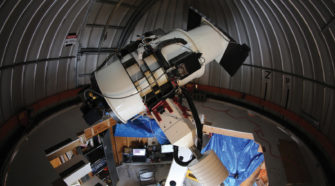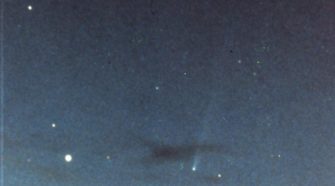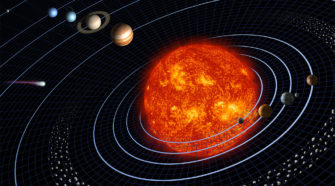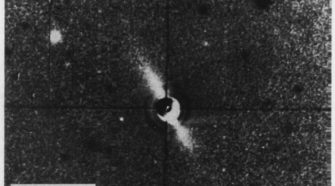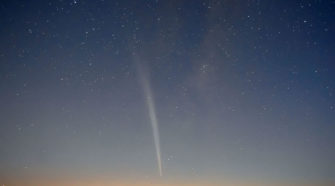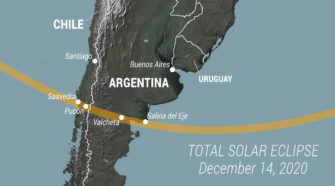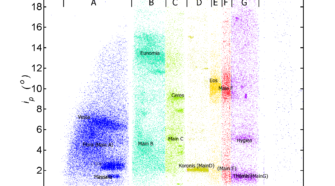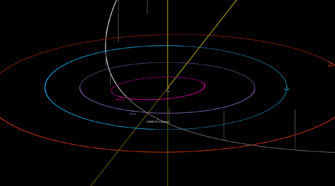Ice and Stone
This Week in History: December 27-31
DECEMBER 27, 1984: A team of American meteorite hunters finds the meteorite ALH 84001 in the Allan Hills region of Antarctica. This meteorite was found to have come from Mars, and in 1996 a team led by NASA scientist David McKay reported the presence of possible “microfossils” and other evidence of potential biological activity within …
Comet of the Week: Kohoutek 1973f
Perihelion: 1973 December 28.43, q = 0.142 AU This comet’s story starts about two years before its actual discovery when Brian Marsden (at the IAU’s Central Bureau for Astronomical Telegrams) performed some orbital calculations of the long-lost periodic Comet 3D/Biela (a previous “Comet of the Week”). The comet had not been seen since the mid-19th Century …
Special Topic: Putting It All Together
When I first began reading about the solar system as an elementary school student in the mid-1960s, it seemed to be a much simpler place than what we know today. There was the sun, around which orbited nine planets; some of these planets had moons, Jupiter having the most with 12. Between Mars and …
This Week in History: December 20-26
DECEMBER 20, 1900: Michel Giacobini at Nice Observatory in France discovers the comet now known as Comet 21P/Giacobini-Zinner. This is the parent comet of the Draconid meteor shower and is also the first comet to be visited by a spacecraft; it is a previous “Comet of the Week.” DECEMBER 21, 1969: Comet Tago-Sato-Kosaka 1969g passes …
Comet of the Week: Lovejoy C/2011 W3
Perihelion: 2011 December 16.08, q = 0.006 AU In the “Special Topics” presentation on Kreutz sungrazers eight weeks ago I mentioned that in 2007 Zdenek Sekanina and Paul Chodas published a paper wherein they predicted that a new “cluster” of sungrazers should be arriving within the next few decades, with “its earliest member possibly just several …
Special Topic: Formation of the Planets
Ever since humankind began to discern the overall structure of the solar system a few centuries ago, i.e., that the sun basically resides in the center and the planets orbit around it, this has brought forth questions, for example, how did the planets, and the solar system as a whole, form? A second question would …
This Week in History: December 13-19
DECEMBER 13, 2012: China’s Chang’e 2 mission encounters the Apollo-type asteroid (4179) Toutatis, coming to within 3.2 km of the asteroid. Chang’e 2 and other missions to the solar system’s “small bodies” are discussed in a previous “Special Topics” presentation. DECEMBER 14, 1807: A meteorite falls to the ground near Weston, Connecticut. An ordinary chondrite, …
Comet of the Week: The Great Comet of 1680
Perihelion: 1680 December 18.49, q = 0.006 AU This particular comet was undoubtedly one of the brightest comets of the 17th Century, but it is also one of the most important comets in history from a scientific perspective, and perhaps even from the perspective of overall human history. While there were certainly plenty of superstitions attached …
Special Topic: “Families” and Groups
A detailed examination of a catalog of orbital elements of comets and/or asteroids will reveal that the orbits therein are not entirely random; rather, there will appear to be various objects that seem to share similar orbits. While in some instances these resemblances may be coincidental, in many more cases the similarities are real, and …
This Week in History: December 6-12
DECEMBER 6, 1997: Jim Scotti with the Spacewatch program in Arizona discovers the Apollo-type asteroid now known as (35396) 1997 XF11. This asteroid created a major stir the following year when orbital calculations indicated a very close approach to Earth would be occurring in October 2028, and even though subsequent calculations with more data moved …

